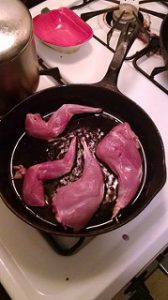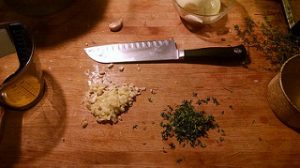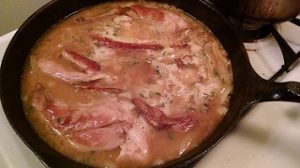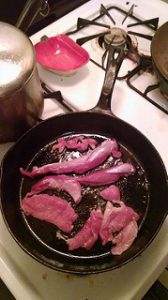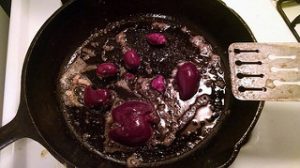This weekend, I killed a rabbit with my bicycle.
Warning: This post contains descriptions of a dead animal, and processing an animal for consumption. I have included graphic photos of the animal and the process below.
Goodnight, Rabbit
Saturday night I was slowly rolling down the Greenway from Kinkos, with my panniers full of paper and things for Sunday’s 6th Annual Winter Biking Skill Share. It was 9pm, dark, quiet. I was on my way to my dear friend Melanie’s dinner party, and I was wearing a party dress and didn’t want to get sweaty on the way there so I was taking it easy, probably going all of 10mph. All of a sudden I felt something, heard something, and out of the corner of my eye, saw something. I say “something” because I’m still not exactly sure what happened, but my first thought was that something fell out of my pannier. I pulled over, clicked my helmet light on, and saw that I had hit/ a bunny had hit my bike.
Poor little thing!
I went over and prodded it to see if I had killed it, and it hopped into the “crouch” position. Oh good! I probably just knocked the lil’ guy out somehow. I petted the bunny while it seemed to be gathering its wits, and after a minute, picked it up to help it off the trail. It gave a shudder. It was a cold night, so I grabbed the plastic bag I keep stashed under my leather saddle to keep it dry when it rains, placed the bunny in there and put it in my jacket to see if that would help him along. (Wild animals have fleas and ticks and other things that I didn’t want in my jacket. I left his head out, I just loosely had his fur covered in the bag.) That’s when I realized the shudder was the bunny dying.

So I’m on the Greenway, in the dark, with a dead bunny in my hands, still warm, with his eyes open. I checked his body over, and there was no evidence that I had run over his body or that he had any sores or wounds. I think the bunny just hit his head so hard he wouldn’t be waking up in the morning. All things considered, not the worst way to go.
I always carry a plastic bag under my seat. I also always carry a sharp knife.
My first thought was to move the dead animal to the ditch and continue on. But… something about that didn’t really appeal to me. This rabbit died in my hands. I could still feel the warmth and energy in its body. Leaving something warm on the side of the road didn’t feel right to me, so I decided I would take the meat and eat the rabbit. If you’ve eaten fresh game, or fresh meat, you know that there is something special about it. The meat, dead, still contains some element of life, some trace of vibrating life energy. This is in contrast to the pieces of trimmed red protein presented on styrofoam trays and squished by plastic wrap you see at grocery stores.
Things I Know About Rabbits
They have a high internal temperature. If you are going to eat a dead rabbit, you need to skin and clean it ASAP, especially if the day is hot, because the meat will start to rot very quickly.
Their fur comes off very easily, especially if the body is still warm. If you were in a survival situation, you wouldn’t even need a knife. You could use a sharp rock or stick to get it started.
Rabbit skin is pretty thin, and if you get too rough you can rip the pelt as you roll it off the body. If you are interested in the pelt, be gently and maybe use a knife to help remove the membrane between skin and meat.
Skinning and Cleaning
If you ever need to skin and clean a rabbit, there are plenty of tutorials online. I found this one to be very thorough with lots of descriptions, tips, and helpful photographs. Here is another one. (I believe both are written by women.) I personally know two methods for skinning them. One is the quick method of making a small incision in the middle of the back (hold the fur away from the body), and removing it in two pieces, one piece working toward the tail, and the other piece working toward the head. You do this when you don’t want the pelt in one piece. The other method is to hold the rabbit by a rear foot, cut around the ankle joint to separate the fur from the foot, cut an “inseam”, and gently roll the pelt toward the head. This is good if you care about the pelt.
Well, I had a dinner party to get to, so I worked fast, and I worked efficient. I broke the neck of the rabbit first, just to doubly triply make sure this rabbit wouldn’t feel any pain in case he was only mostly dead (this was… overkill), removed the pelt in two pieces, leaving the tail, socks, and head for later, because I was in a rush. I pinched some skin away from the innards at the lower abdomen and made an incision the size of a quarter. I put two fingers of my left hand into the incision pulled the abdominal skin up and away from the body, carefully using my knife to cut a seam from the belly to the bottom of the rib cage.
(If you would like to see a photo of the pelt halfway off of the carcass, click here.)
Things I Know About Rabbits
Sick rabbits smell bad, have sores, have cloudy eyes, bright spots on their livers. I inspected this young buck and he got a clean bill of health.
DO NOT PUNCTURE THE GALL, POO SACK, or PEE SACK. If you do any of these things wash it off immediately. If gall, poo, or pee sits on the meat, discard the animal and wash your hands really well. Game over.
To remove the gall bladder or urine bladder, go to the part of the sack where it is connected, and pinch firmly without squeezing the bladder, and twist and pull to remove. Pitch them.
I always carry a plastic bag, and a sharp knife. On this evening I happened to have an empty mason jar from the day’s lunch.
I removed the kidney and liver (remove the gall bladder) and put them in the mason jar. I put my hand in along the spine and carefully scooped out the rest of the organs, taking care not to puncture the colon or bladder. Cut the pelvis and clean its butt. Between the rib cage and abdominal cavity there is a membrane you want to cut into to remove the heart, which I put in my jar. I removed the lungs and discarded them. I used my water bottle to rinse the carcass a little bit. I walked a block to the community garden to rinse my hands.
The moon was about three-quarters full that night. After field dressing the animal while I was wearing a party dress, I took a moment to appreciate the animal. Thank you, Rabbit.
It was 27 degrees, so I put the mason jar and rabbit in the plastic bag, secured it to my rear rack and went to the party. (First stop was the bathroom for some thorough soap and hot water hand-washing!) A few hours later I took the rabbit home with me, and finished the job in my basement, removing the head and feet with my same small knife. I put a strainer in the utility sink and thoroughly rinsed and cleaned the carcass with very cold water, and rinsed the organs. I put it in a ziplock bag, inside of a paper bag so it wouldn’t freak out my roommate, and went to bed.
Butchering
The next day, after the Skill Share, I decided to try my hand at butchering. I found this guide helpful. And this is a different approach. (Both have detailed photos.) I’ve never done this part before, and it wasn’t that difficult, but I definitely didn’t do the most clean and beautiful job. Sorry, Rabbit. I estimate the young buck yielded about 1.5-2 pounds of very lean meat.
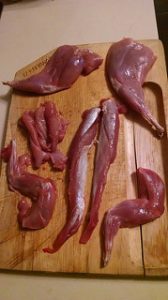
Cooking
I personally do not eat chicken, but I enjoy rabbit meat. Some people say that rabbit tastes like chicken, but I can’t speak to that. I do know that you can use most chicken recipes for rabbit meat.
Braisés Lapin, with Lemon Miso Sauce
Brown the meat in oil on medium temperature.
Remove the rabbit from the pan, and add chopped onions. Sautee until tender.
Add chopped garlic and fresh thyme, and cook for a minute until fragrant.
Combine 1/4 cup stock (I was out so I used miso), some lemon juice, a couple tablespoons of water and 4-5 tablespoons of flour, whisk smooth.
Add rabbit and sauce back into the pan, bring to a boil, make sure meat reaches an internal temperature of 160F.
Remove rabbit, cook down until sauce thickens.
Serve.
Rabbit Cooked in Oil
I put the belly, back/loin, and breast in a pan with butter, on medium heat, and added a little salt and pepper, and at these while the front and hind limbs cooked with the onions and sauce, because I couldn’t wait and I like simple preparation.
I put the organs I had saved in the pan with some butter, on low/medium heat, and cooked them for a few minutes on each side. I sprinkled on some salt and pepper and savored these pieces.
Rabbit Liver Pate
I did not have enough liver to make pate, but if you feel so inclined, this is how I would do it.
- Salt 1 or 2 livers on both sides.
- Add 1 tablespoon of butter to a hot pan until it starts to bubble.
- Add the liver, and after 30 seconds to a minute, flip it, then remove from the pan.
- Add another tablespoon of butter and 3 tablespoons of minced shallot (or less onion if you don’t have shallots) and minced garlic while lowering the heat.
- After everything starts to soften and come together add a couple splashes of cognac, sherry or port, and deglaze the pan.
- Finely chop everything up together, and optionally smoosh it with the side of your knife to make a paste. (If you had a ton of liver you could use the food processor, but this has been such a hands-on process so far, why introduce a machine?)
- Stick a sprig of thyme in it for pretties, and salt and pepper to taste.
Things I Learned
- Always carry a plastic bag under your seat.
- You can eat city rabbits.
- The front limbs are not connected with bone, only ligaments and muscle.
- I should have soaked the carcass after I finished dressing it, but I didn’t, and it was just fine.
- You can, after removing blood from the hide, put pelts in the freezer for tanning later. It doesn’t damage the pelt.
- To identify tapeworms, you want to look for cysts attached to the liver, intestines, gut or lungs.
Thank You, Rabbit
In closing, I want to mention I didn’t write this to be shocking or disrespectful to the animal I killed. I love animals, and I felt sadness when the bunny died in my hands. Eating this animal was the way I chose to respect its life. I wrote this because I thought some people might be interested that you can eat city rabbit, and that it is very easy to field dress and prepare small game, if you chose to go that route. Thank you for reading. And thank you, Rabbit.

